Virtual reality (VR) is no longer just for gaming and entertainment. In recent years, it has been adopted by various industries to enhance employee training and learning experiences. The benefits of VR in training are numerous, especially in the workplace; compared to lectures (5%), reading (10%), and audio-visual learning (20%), 360 VR training has a retention rate of 75% (Finances Online).
Here at Sliced Bread Animation, we specialise in creating bespoke VR training experiences for our clients. Our 360 VR training programs offer immersive scenarios and simulations, allowing your employees to practise and develop their skills in a safe and controlled environment. From surgeons to construction workers; our software can simulate a wide range of situations, providing learners with a unique and engaging learning experience.
In this article, we’ll explore the business benefits of 360 VR training, providing advice on creating VR training programs and highlighting the potential of this technology to revolutionise workplace learning.
So, buckle up – a new world of interactive virtual reality training and development is here.
Creating Immersive 360 VR Training Experiences
Cutting-edge VR technology offers the ultimate tool for enhanced learning, allowing employees to immerse themselves in scenarios that replicate real-life situations. With 360 VR training, your employees can develop skills in a safe and controlled environment, whether it’s operating equipment and machinery, performing surgical procedures, or practising safety procedures in hazardous situations. The immersive nature of VR training provides learners with an unparalleled experience that enhances their knowledge and retention of critical information.
Creating a VR training course may seem daunting, but our team at Sliced Bread Animation has the expertise and technology to bring your vision to life. Our software and machine learning capabilities allow us to design scenarios and simulations that are tailored to your business needs, ensuring that your employees receive the best possible training experience, whether it’s for an online course, a classroom course, or is being undertaken on a computer or mobile device. Video training using VR is incredibly flexible and engaging by nature, making it applicable to almost every industry.










